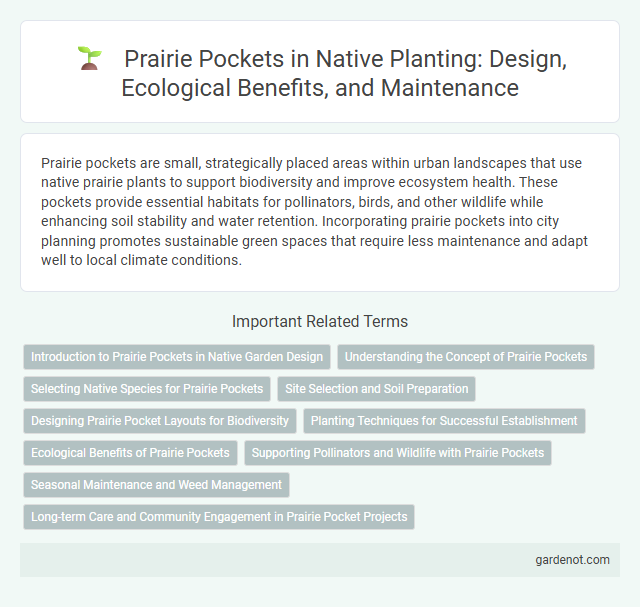Prairie pockets are small, strategically placed areas within urban landscapes that use native prairie plants to support biodiversity and improve ecosystem health. These pockets provide essential habitats for pollinators, birds, and other wildlife while enhancing soil stability and water retention. Incorporating prairie pockets into city planning promotes sustainable green spaces that require less maintenance and adapt well to local climate conditions.
Introduction to Prairie Pockets in Native Garden Design
Prairie pockets are strategically designed plant groupings that mimic natural prairie ecosystems, enhancing biodiversity and resilience in native garden design. These clusters emphasize deep-rooted native grasses and wildflowers, promoting soil health and supporting pollinators like bees and butterflies. Integrating prairie pockets into landscapes fosters sustainable habitats and reflects authentic ecological patterns found in native prairies.
Understanding the Concept of Prairie Pockets
Prairie pockets are strategically designed small native plant clusters that enhance biodiversity and support local wildlife habitats within urban or disturbed landscapes. These compact ecosystems combine deep-rooted prairie grasses and wildflowers, improving soil health, reducing erosion, and increasing pollinator activity. Implementing prairie pockets helps restore natural prairie functions by mimicking native plant communities on a manageable, localized scale.
Selecting Native Species for Prairie Pockets
Selecting native species for prairie pockets involves choosing deep-rooted grasses such as big bluestem (Andropogon gerardii), switchgrass (Panicum virgatum), and native wildflowers like purple coneflower (Echinacea purpurea) and black-eyed Susan (Rudbeckia hirta) to establish resilient, drought-tolerant ecosystems. Emphasizing species adapted to local soil and climate conditions enhances biodiversity, supports pollinators, and promotes soil health by mimicking natural prairie functions. Integrating diverse native plants ensures year-round ecological benefits and contributes to habitat restoration efforts in urban or suburban landscapes.
Site Selection and Soil Preparation
Prairie pocket restoration requires selecting well-drained sites with full sun exposure to promote native grass and wildflower growth. Soil preparation involves removing invasive species and loosening compacted soil to improve aeration and water infiltration. Amending soil with organic matter enhances nutrient availability, supporting healthy prairie plant establishment.
Designing Prairie Pocket Layouts for Biodiversity
Designing prairie pocket layouts for biodiversity involves selecting diverse native grasses and wildflowers that provide habitat and food sources for pollinators, birds, and small mammals. Incorporating varying plant heights and bloom times maximizes shelter and nutritional availability throughout the seasons. Strategic placement of plant clusters and pathways enhances ecological connectivity, supporting urban wildlife and promoting ecosystem resilience.
Planting Techniques for Successful Establishment
Prairie pocket planting techniques emphasize careful soil preparation and the strategic placement of native seeds to enhance germination rates and root development. Using a no-till drill ensures minimal soil disturbance while allowing seeds to be planted at the optimal depth for prairie species like little bluestem and black-eyed Susan. Regular monitoring and targeted weed control during the first growing season increase the likelihood of successful establishment and long-term prairie health.
Ecological Benefits of Prairie Pockets
Prairie pockets provide essential habitats that enhance biodiversity by supporting pollinators, birds, and small mammals, contributing to ecosystem stability. These native plant clusters improve soil health through deep root systems that prevent erosion and increase water infiltration. By integrating prairie pockets into urban and agricultural landscapes, they help mitigate climate change effects through carbon sequestration and temperature regulation.
Supporting Pollinators and Wildlife with Prairie Pockets
Prairie pockets serve as vital habitats within native planting landscapes, providing essential resources such as nectar, pollen, and shelter for pollinators like bees, butterflies, and hummingbirds. By incorporating diverse native flowering plants, prairie pockets enhance biodiversity and support the life cycles of numerous wildlife species, including beneficial insects and small mammals. These microhabitats contribute to ecosystem resilience and promote sustainable urban and rural environments by facilitating pollination and offering refuge amid surrounding development.
Seasonal Maintenance and Weed Management
Prairie pocket plantings require seasonal maintenance to support plant health and biodiversity, including periodic mowing or controlled burns to mimic natural disturbance regimes and promote native species growth. Effective weed management involves early detection and removal of invasive species such as Canada thistle and reed canary grass, which compete with native prairie plants for resources. Consistent monitoring and targeted herbicide applications during the growing season help maintain a balanced prairie ecosystem and enhance long-term resilience.
Long-term Care and Community Engagement in Prairie Pocket Projects
Prairie pocket projects emphasize long-term care by promoting native planting techniques that enhance ecosystem resilience and biodiversity. Community engagement is integral, involving volunteer participation and educational programs to ensure sustainable maintenance and stewardship of prairie habitats. Monitoring and adaptive management practices foster thriving native plant populations that support local wildlife over time.
Prairie pocket Infographic

 gardenot.com
gardenot.com